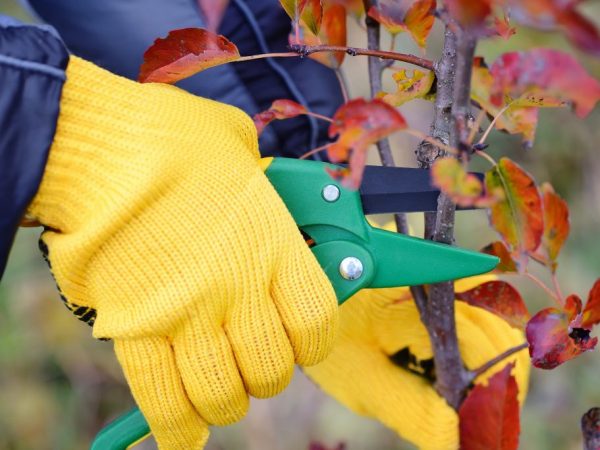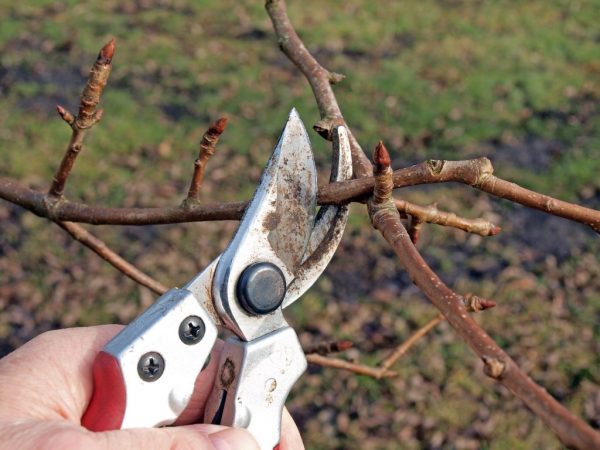Pruning a Columnar Pear
Pruning a columnar pear is slightly different from the procedure used for other pear varieties. This is due to the peculiarities of the columnar varieties.

Pruning a Columnar Pear
Purpose of trimming
Columnar pears belong to dwarf ones, they are low (no more than 2.5 m), without branches, therefore, incorrect pruning can lead to a decrease in yield and in some cases causes the death of a fruit crop.
Nevertheless, pruning a columnar pear according to the established rules will allow:
- increase productivity indicators;
- give access to sunlight and air to the entire pear crown, which will affect the quality of plant nutrition;
- simplify plant and fruit care;
- extend the fruiting period of garden culture.
- by trimming the columnar pear to form a strong central trunk and main branches capable of withstanding the weight of ripening fruits.
Pruning a neglected pear tree for a long time without proper care is a method of rejuvenating an old plant that can increase the duration of the crop's fruiting.
Pear pruning seasons
By the time of pruning a columnar pear, gardeners have different approaches.
Spring
Most gardeners are convinced that the best time to prune this variety, like other pear varieties, is spring. This is due to the fact that during this period there is a flow of juice reduced in activity. As a result, it is easier for the plant to endure the pruning procedure.
Pruning of a columnar pear in spring is carried out if the air temperature is established, its decrease is not expected.
Spring pruning in regions with a warm climate is carried out in March, with a cooler one - not earlier than the first days of April.
Summer
Few dare to prune fruit crops in summer. Most gardeners do not recommend this event in the summer, because along with the trimmed branches, the grown foliage that participates in the process of photosynthesis and is responsible for the full nutrition of the plant is removed.
It is better to cut such a pear in summer in June, when there is active growth and development of shoots.
Autumn

Non-fruiting shoots are removed
Pruning of a columnar pear in autumn is carried out as a sanitary measure; it includes the removal of damaged branches, through which juice no longer circulates and food is not delivered. At the same time, the processes that do not produce fruit are cut off, but that take away the strength from the plant.
It is recommended to prune columnar varieties in autumn at the beginning of the season, before the cold has yet come.
Spring pruning
In the spring, columnar varieties are pruned to form a crown and remove unnecessary stress on thin shoots, to simplify the care of the fruit crop. This variety is not prone to thickening, so the procedure is carried out to a minimum:
- immediately after planting the pear tree, pinch off all the lateral processes: this will make it possible to strengthen the main trunk,
- the central trunk is not cut in the spring,
- in a mature, rooted tree, 2-3 lateral processes are removed every spring, depending on the desired shape of the pear crown.
After shortening the central trunk, an activation of the growth of lateral shoots is observed, at this time the fruit harvest is closely monitored. With a decrease in the quality of the yield, when the fruits become smaller, and their quality characteristics are worse, in the spring it is required to thin out the lateral shoots.
Autumn pruning
Pruning pear varieties in the fall should only be at above-zero temperatures, when dry foliage has fallen from the tree.
The scheme of the autumn procedure involves holding the event in several stages:
- a year after planting the pear tree, the main branch is cut off at a distance of about half a meter from the surface of the earth, while the cut is made at the place of bud growth and, without fail, from the side opposite to where the vaccination was carried out;
- after 2 years of growth, the central trunk is cut off at a height of 0.25 m from the place of growth of the bud, which is located above the last year's shoot;
- in the 4th year, by autumn, the tree will have about 6-8 branches, of which only the strongest are left, no more than 3-4, and they are cut off at an equal height, the central trunk is cut off 0.2 m higher than it was done in the fall of the previous year.
With each autumn procedure, the tips and lateral processes are cut off from the branches in order to ensure the growth of new branches next year. At the same time, dry branches are cut off.
Autumn pruning is not performed if the tree was planted in spring. The reason for this is the poor development of branches of young columnar plants.
Conclusion
Pruning a columnar pear is a specific process. In order not to harm the culture, the peculiarities of pruning in each of the seasons are taken into account.


